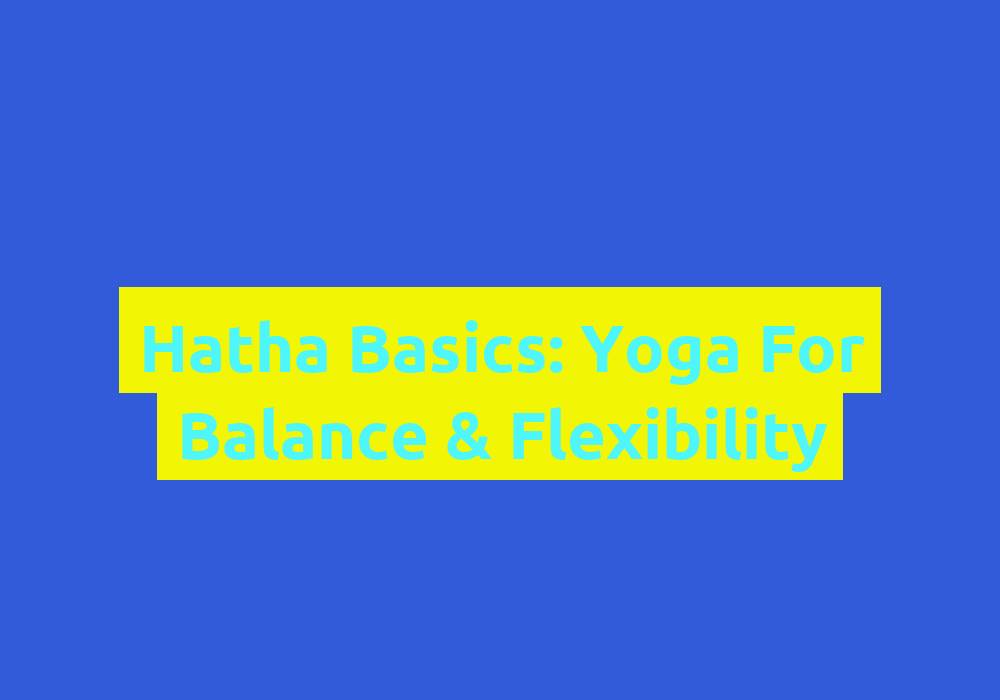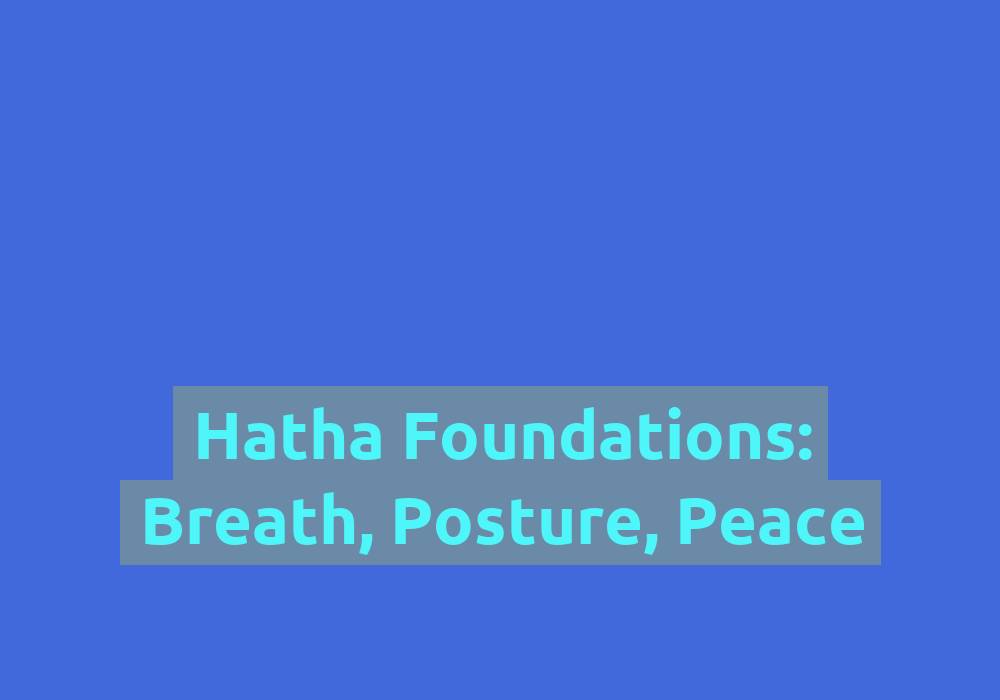Hatha Basics: Yoga for Balance & Flexibility

Yoga is an ancient practice that aims to harmonize the body, mind, and spirit. Among its various styles, Hatha yoga stands out as a foundational practice that focuses on balance and flexibility. In this article, we will dive deep into the basics of Hatha yoga, exploring its benefits, key postures, and how it can enhance your overall well-being.
What is Hatha Yoga?
Hatha yoga is a discipline that originated in India over 5,000 years ago. The term Hatha is derived from two Sanskrit words: ha meaning sun and tha meaning moon. It symbolizes the balance of opposing forces within the body and aims to unite them.
Hatha yoga involves physical postures (asanas), breathing techniques (pranayama), and meditation (dhyana). It focuses on aligning the body, breath, and mind to create a state of harmony and balance. Unlike some other yoga styles that may be more fast-paced or intense, Hatha yoga is gentle and suitable for practitioners of all levels.
Benefits of Practicing Hatha Yoga
Hatha yoga offers a wide range of benefits that can positively impact your physical, mental, and emotional well-being. Let’s explore some of these benefits in detail:
Enhanced Balance: Hatha yoga practitioners work on improving their balance through various asanas. Regular practice helps strengthen the core muscles, promotes proper body alignment, and improves overall stability. By challenging the body’s equilibrium, Hatha yoga helps develop a strong foundation for balance in everyday life.
Increased Flexibility: Flexibility is a key component of Hatha yoga. The practice incorporates stretching exercises that target different muscle groups, enhancing their range of motion and flexibility over time. Improved flexibility not only allows for greater ease in performing yoga poses but also helps prevent injuries and promotes better posture.
Stress Reduction: The combination of deep breathing techniques and gentle movements in Hatha yoga helps calm the mind and reduce stress. It encourages relaxation, promoting a sense of inner peace and tranquility. By focusing on the present moment and letting go of external distractions, Hatha yoga becomes a powerful tool for stress management.
Improved Posture: Many Hatha yoga poses focus on proper alignment and posture. Regular practice helps correct postural imbalances, alleviates back and neck pain, and improves overall body posture. By strengthening the muscles that support the spine and promoting awareness of body alignment, Hatha yoga helps cultivate good posture both on and off the mat.
Physical Strength: While Hatha yoga may appear gentle, it can still be physically challenging. Holding poses and transitioning between them requires strength and endurance, leading to improved overall physical fitness. As you progress in your practice, you’ll notice increased muscle tone, stability, and functional strength, which can benefit you in various aspects of daily life.
Mental Clarity: The meditation aspect of Hatha yoga cultivates mental clarity and sharpness. The practice encourages mindfulness and self-awareness, allowing practitioners to develop a focused and calm mind. By quieting the mental chatter and promoting a sense of inner stillness, Hatha yoga helps improve concentration, memory, and cognitive abilities.
In addition to these benefits, Hatha yoga can also promote better sleep, boost immune function, increase energy levels, and enhance overall well-being.
Key Hatha Yoga Postures
To fully experience the benefits of Hatha yoga, it’s important to familiarize yourself with some key postures. Here are a few examples:
Mountain Pose (Tadasana): Stand tall with feet together, grounding your body into the earth. Lengthen your spine, relax your shoulders, and engage your core muscles. This posture improves posture and strengthens the legs. In Mountain Pose, imagine yourself rooted like a mountain, grounded and stable.
Downward Facing Dog (Adho Mukha Svanasana): Begin on all fours, then lift your hips up and back, creating an inverted V-shape with your body. Press your palms and heels into the ground, engaging your arms and legs. Downward Dog stretches the hamstrings, calves, and shoulders while strengthening the upper body. This pose also helps relieve tension in the spine and promotes a gentle inversion, which can have energizing effects.
Warrior I (Virabhadrasana I): Step one foot forward into a lunge position, ensuring your front knee is directly above your ankle. Raise your arms overhead, keeping your shoulders relaxed. This pose builds strength in the legs and opens the chest and shoulders. Warrior I is a powerful posture that cultivates strength, determination, and a sense of empowerment.
Tree Pose (Vrikshasana): Stand tall and bring one foot to rest on the inner thigh or calf of the opposite leg. Find your balance and place your hands in prayer position at your chest. Tree pose improves balance and strengthens the muscles of the standing leg. This pose also encourages a sense of rootedness and stability, while simultaneously promoting flexibility and focus.
Bridge Pose (Setu Bandhasana): Lie on your back with knees bent and feet hip-width apart. Press your feet into the ground, lift your hips, and interlace your fingers beneath your body. Bridge pose strengthens the glutes, hamstrings, and lower back while opening the chest. This pose also helps counteract the effects of sitting for long periods, improves spinal flexibility, and stimulates the thyroid gland.
These are just a few examples of the many postures you can explore in Hatha yoga. It’s important to practice under the guidance of a qualified instructor to ensure proper alignment and avoid injury. A skilled teacher can help you modify poses to suit your individual needs and ensure you receive the maximum benefits from each posture.
How to Incorporate Hatha Yoga into Your Routine
Now that you understand the benefits and have learned some key postures, let’s explore how you can incorporate Hatha yoga into your routine:
Find a Suitable Space: Dedicate a quiet and clean space where you can practice without distractions. It could be a spare room, a corner of your living room, or even a peaceful outdoor spot. Creating a designated space helps set the intention for your practice and allows you to fully immerse yourself in the experience.
Choose the Right Time: Select a time of day that works best for you. Some people prefer practicing yoga in the morning to energize their day, while others find it beneficial to wind down with a session in the evening. Find a time that aligns with your schedule and allows you to practice without feeling rushed or pressured.
Start with Warm-Up Exercises: Before diving into the asanas, warm up your body with gentle stretches and joint mobilization exercises. This helps prepare your muscles and joints for the deeper stretches to come. Incorporate movements that target the major muscle groups and areas of tension, such as neck rolls, shoulder rotations, and spinal twists.
Follow a Sequence: Create a sequence of asanas that flow smoothly from one to another. You can either design your own sequence or follow a guided video or class. Ensure that you include a balance of standing, seated, and supine poses to work different areas of the body. Consider incorporating both dynamic movements and longer holds to challenge your strength and flexibility.
Practice Mindful Breathing: Throughout your practice, pay attention to your breath. Practice deep, diaphragmatic breathing to enhance relaxation and focus. Coordinate your breath with each movement, inhaling as you lengthen or expand and exhaling as you contract or release. By connecting breath and movement, you create a meditative flow that deepens your practice.
End with Relaxation: Conclude your Hatha yoga practice with Savasana (Corpse Pose), a relaxation posture where you lie on your back, arms and legs extended. Allow your body and mind to fully unwind and absorb the benefits of your practice. Use this time for reflection, gratitude, or simply to experience a sense of deep relaxation and rejuvenation.
Remember to listen to your body and respect its limits. It’s more important to practice with proper alignment and mindfulness rather than pushing yourself too hard. If you experience any discomfort or pain during a pose, modify it or seek guidance from a qualified instructor.
Conclusion
Hatha yoga offers a holistic approach to attaining balance and flexibility. By incorporating physical postures, breathing techniques, and meditation, Hatha yoga cultivates a harmonious connection between the body, mind, and spirit. Regular practice can lead to enhanced balance, increased flexibility, reduced stress, improved posture, physical strength, and mental clarity. So, roll out your mat, take a deep breath, and embark on a journey of self-discovery and well-being through Hatha yoga.
Note: The complete article is provided in markdown format below:
“`
Yoga is an ancient practice that aims to harmonize the body, mind, and spirit. Among its various styles, Hatha yoga stands out as a foundational practice that focuses on balance and flexibility. In this article, we will dive deep into the basics of Hatha yoga, exploring its benefits, key postures, and how it can enhance your overall well-being.
What is Hatha Yoga?
Hatha yoga is a discipline that originated in India over 5,000 years ago. The term Hatha is derived from two Sanskrit words: ha meaning sun and tha meaning moon. It symbolizes the balance of opposing forces within the body and aims to unite them.
Hatha yoga involves physical postures (asanas), breathing techniques (pranayama), and meditation (dhyana). It focuses on aligning the body, breath, and mind to create a state of harmony and balance. Unlike some other yoga styles that may be more fast-paced or intense, Hatha yoga is gentle and suitable for practitioners of all levels.
Benefits of Practicing Hatha Yoga
Hatha yoga offers a wide range of benefits that can positively impact your physical, mental, and emotional well-being. Let’s explore some of these benefits in detail:
Enhanced Balance: Hatha yoga practitioners work on improving their balance through various asanas. Regular practice helps strengthen the core muscles, promotes proper body alignment, and improves overall stability. By challenging the body’s equilibrium, Hatha yoga helps develop a strong foundation for balance in everyday life.
Increased Flexibility: Flexibility is a key component of Hatha yoga. The practice incorporates stretching exercises that target different muscle groups, enhancing their range of motion and flexibility over time. Improved flexibility not only allows for greater ease in performing yoga poses but also helps prevent injuries and promotes better posture.
Stress Reduction: The combination of deep breathing techniques and gentle movements in Hatha yoga helps calm the mind and reduce stress. It encourages relaxation, promoting a sense of inner peace and tranquility. By focusing on the present moment and letting go of external distractions, Hatha yoga becomes a powerful tool for stress management.
Improved Posture: Many Hatha yoga poses focus on proper alignment and posture. Regular practice helps correct postural imbalances, alleviates back and neck pain, and improves overall body posture. By strengthening the muscles that support the spine and promoting awareness of body alignment, Hatha yoga helps cultivate good posture both on and off the mat.
Physical Strength: While Hatha yoga may appear gentle, it can still be physically challenging. Holding poses and transitioning between them requires strength and endurance, leading to improved overall physical fitness. As you progress in your practice, you’ll notice increased muscle tone, stability, and functional strength, which can benefit you in various aspects of daily life.
Mental Clarity: The meditation aspect of Hatha yoga cultivates mental clarity and sharpness. The practice encourages mindfulness and self-awareness, allowing practitioners to develop a focused and calm mind. By quieting the mental chatter and promoting a sense of inner stillness, Hatha yoga helps improve concentration, memory, and cognitive abilities.
In addition to these benefits, Hatha yoga can also promote better sleep, boost immune function, increase energy levels, and enhance overall well-being.
Key Hatha Yoga Postures
To fully experience the benefits of Hatha yoga, it’s important to familiarize yourself with some key postures. Here are a few examples:
Mountain Pose (Tadasana): Stand tall with feet together, grounding your body into the earth. Lengthen your spine, relax your shoulders, and engage your core muscles. This posture improves posture and strengthens the legs. In Mountain Pose, imagine yourself rooted like a mountain, grounded and stable.
Downward Facing Dog (Adho Mukha Svanasana): Begin on all fours, then lift your hips up and back, creating an inverted V-shape with your body. Press your palms and heels into the ground, engaging your arms and legs. Downward Dog stretches the hamstrings, calves, and shoulders while strengthening the upper body. This pose also helps relieve tension in the
What is Hatha Yoga?
Hatha yoga is a discipline that originated in India over 5,000 years ago. It involves physical postures, breathing techniques, and meditation to create a state of harmony and balance in the body, breath, and mind.What are the benefits of practicing Hatha Yoga?
Some benefits of practicing Hatha yoga include enhanced balance, increased flexibility, reduced stress, improved posture, physical strength, and mental clarity. It can also promote better sleep, boost immune function, increase energy levels, and enhance overall well-being.What are some key Hatha Yoga postures?
Some key Hatha yoga postures include Mountain Pose (Tadasana), Downward Facing Dog (Adho Mukha Svanasana), Warrior I (Virabhadrasana I), Tree Pose (Vrikshasana), and Bridge Pose (Setu Bandhasana).How can I incorporate Hatha Yoga into my routine?
To incorporate Hatha yoga into your routine, find a suitable space, choose the right time, start with warm-up exercises, follow a sequence of asanas, practice mindful breathing, and end with relaxation. It’s important to listen to your body, practice with proper alignment, and seek guidance from a qualified instructor if needed.

